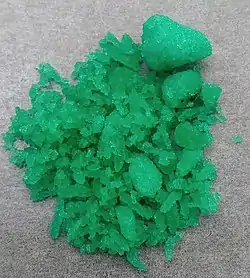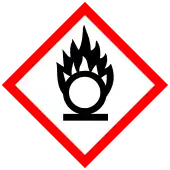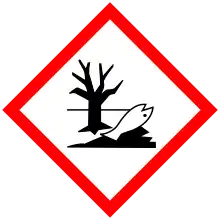 Some green nickel(II) perchlorate hexahydrate powder. | |
| Names | |
|---|---|
| IUPAC name
Nickel(II) perchlorate | |
| Other names
Nickel diperchlorate Nickel perchlorate Nickel(II) chlorate(VII) Nickel diperchlorate(VII) Nickel perchlorate(VII) | |
| Identifiers | |
| |
3D model (JSmol) |
|
| ChemSpider | |
| ECHA InfoCard | 100.033.735 |
| EC Number |
|
PubChem CID |
|
CompTox Dashboard (EPA) |
|
| |
| |
| Properties | |
| Ni(ClO4)2 | |
| Molar mass | 257.8636 g/mol (hydrate) 329,92472 g/mol (tetrahydrate) 347.94 g/mol (pentahydrate) 365,95528 g/mol (hexahydrate) 420,00112 g/mol (nonahydrate) |
| Appearance | cyan crystals (hydrate) long green needle-shaped crystals (pentahydrate)[1] green crystals (hexahydrate) |
| Density | 2.98 g/cm³ (hydrate)[2] 1,508 g/cm³ (hexahydrate) |
| Melting point | 140 °C (284 °F; 413 K) (hexahydrate) 149 °C (300 °F; 422 K) (partially decomposed pentahydrate) 103 °C (217 °F; 376 K)) |
| 259 g/100 mL (hexahydrate)[3] | |
| Solubility | soluble in alcohol, aceton insoluble in chloroform forming compounds with ammonia, hydrazine, urea, semicarbazide, carbohydrate, thioure |
| Hazards | |
| Occupational safety and health (OHS/OSH): | |
Main hazards |
oxidization |
| GHS labelling: | |
    | |
| Danger | |
| H271, H314, H317, H334, H341, H350, H360, H372, H410 | |
| P201, P260, P273, P280, P303+P361+P353, P304+P340+P310, P305+P351+P338, P308+P313, P391[4] | |
| Flash point | flammable |
| Related compounds | |
Other anions |
Nickel perrhenate Nickel nitrate |
Other cations |
Iron(II) perchlorate Copper(II) perchlorate |
Except where otherwise noted, data are given for materials in their standard state (at 25 °C [77 °F], 100 kPa).
Infobox references | |
Nickel(II) perchlorate is a inorganic compound with the chemical formula of Ni(ClO4)2, and it is a strong oxidizing agent. Its colours are different depending on water. For example, the hydrate forms cyan crystals, the pentahydrate forms green crystals,[1] but the hexahydrate (Ni(ClO4)2·6H2O) forms blue crystals.[5]
Preparation
The hexahydrate of nickel(II) perchlorate can be obtained by reacting perchloric acid with nickel(II) hydroxide, nickel(II) chloride or nickel(II) carbonate:[5] The resulting salt is a pentahydrate, Ni(ClO4)2·5H2O. At −21.3 °C (251.9 K; -6.3 °F), the nonahydrate Ni(ClO4)2·9H2O will be formed.[1]
- Ni(OH)2 + 2HClO4 + 4H2O → Ni(ClO4)2•6H2O
Nickel(II) perchlorate can also be obtained by adding nickel to 6 mol/L perchloric acid for electrolysis with an alternating current of 50 Hz.[6]
The yellow anhydrous product is obtained by adding nickel(II) trifluoroacetate and perchloric acid in a trifluoroacetic acid solvent.[3][7][8]
Properties
Nickel(II) perchlorate hexahydrate is a green odourless crystalline solid that is highly soluble in water and soluble in many organic solvents.[9] It begins to decompose from a temperature of 103 °C. It has the hexagonal crystal structure with space group P6/mmm (No. 191).[10] In addition to the hexahydrate, there is also a nonahydrate,[11] a tetrahydrate,[11] a hydrate[2] and a pentahydrate.[1]
Applications
Nickel(II) perchlorate hexahydrate is used in the manufacture of other chemical compounds.[4] For example, it is used as a starting material for homometallic trinuclear scorpionate complexes in studies of electronic and magnetic properties.[9] It also serves as a detonator in explosives.[12]
Other compounds
- Ni(ClO4)2 also forms some compounds with NH3, such as Ni(ClO4)2·6NH3 which is a light purple crystal.[13]
- Ni(ClO4)2 also forms some compounds with N2H4, including Ni(ClO4)2·2N2H4 as a light positive solid[14] or Ni(ClO4)2·5N2H4 which are purple crystals.[15]
- Ni(ClO4)2 forms compounds with CO(NH2)2, like Ni(ClO4)2·6CO(NH2)2 which is a yellow-green solid.[16]
- Ni(ClO4)2 forms compounds with CON3H5, for example Ni(ClO4)2·3CON3H5 which is a blue solid.[17]
- Ni(ClO4)2 forms compounds with CON4H6, such as Ni(ClO4)2·3CON4H6 which is an explosive blue crystal with a bulk density of 0.95 g/cm³.[18]
- Ni(ClO4)2 can also form compounds with CS(NH2)2, such as Ni(ClO4)2·6CS(NH2)2 which is a pale green solid.[19]
- Ni(ClO4)2 also forms some compounds with CSN3H5, such as Ni(ClO4)2·2CSN3H5·3H2O which is a blue paramagnetic crystal[20] or Ni(ClO4)2·3CSN3H5·2H2O which is a dark positive crystal.[21]
- Ni(ClO4)2 also forms some compounds with pyridine.[22]
See also
References
- 1 2 3 4 Nickel Perchlorate, Ni(ClO4)2
- 1 2 Handbook… (Pierre Villars, Karin Cenzual, Roman Gladyshevskii; Walter de Gruyter GmbH & Co KG, 24 thg 7, 2017 - 1970 pages), page 442. Retrieved February 8, 2021.
- 1 2 谢高阳 等. 无机化学丛书 锰分族 铁系 铂系. 科学出版社, 2011. pp 290. 镍(II)的卤酸盐和高卤酸盐
- 1 2 Sigma-Aldrich Co., product no. {{{id}}}.
- 1 2 Daniela Sustac Roman (2001-01-01), "Nickel (II) perchlorate hexahydrate", Encyclopedia of Reagents for Organic Synthesis (in German), John Wiley & Sons, Ltd, ISBN 978-0-470-84289-8
- ↑ 郭花枝,魏建红,张美月. 交流电解制备高氯酸镍[J]. 化学世界, 1991 (12): 531–533.
- ↑ D. Nicholls (2013), The Chemistry of Iron, Cobalt and Nickel Comprehensive Inorganic Chemistry (in German), Elsevier, p. 1131, ISBN 978-1-4831-4643-0
- ↑ Pascal, Jean-Louis; Potier, Jacqueline; Zhang, Cheng Shan (1985). "Chlorine trioxide, Cl2O6, a most efficient perchlorating reagent in new syntheses of anhydrous metal perchlorates, chloryl and nitryl perchloratometalates of cobalt(II), nickel(II), and copper(II). Reactivity of chlorine trioxide with anhydrous or hydrated chlorides and nitrates". Journal of the Chemical Society, Dalton Transactions (2): 297. doi:10.1039/DT9850000297.
- 1 2 Nickel(II) perchlorate hexahydrate, Reagent Grade at AlfaAesar, accessed on {{{Datum}}} (PDF) (JavaScript required).
- ↑ "Ni(ClO4)2·6H2O (Ni[ClO4]2[H2O]6 ht) Crystal Structure". Springer Materials. 2016-07-07.
- 1 2 John Newton (1922). Cobalt, Nickel, and the Elements of the Platinum Group, Volume IX (PDF). ISBN 978-1110346271.
- ↑ Robert D. Morrison, Brian L. Murphy (2010), Environmental Forensics Contaminant Specific Guide (in German), Academic Press, p. 169, ISBN 978-0-08-049478-4
- ↑ A Text-book Of Inorganic Chemistry Vol-x, trang 192 – . Retrieved April 1, 2020.
- ↑ Sciencemadness Discussion Board - Exotic Primaries - Complex Salts. Retrieved May 30, 2020.
- ↑ (de)Bernhard Maissen, G. Schwarzenbach. Eine Substanz von äusserster Gefährlichkeit: Hydrazinnickelperchlorat. HELVETICA CHIMICA ACTA, 1951. 34 (6): 2084–2085. doi: 10.1002/hlca.19510340650
- ↑ Co-ordination compounds of 1,3-dimethylurea. Retrieved May 22, 2020.
- ↑ Soviet Journal of Coordination Chemistry, Tập 2,Phần 2 (Consultants Bureau., 1977), page 944. Retrieved November 8, 2020.
- ↑ M. B. Talawar, A. P. Agrawal, J. S. Chhabra, S. N. Asthana – Studies on lead-free initiators: synthesis, characterization and performance evaluation of transition metal complexes of carbohydrazide. J. Hazard Mater., 113 (1–3), 57–65 (September 10, 2004). doi:10.1016/j.jhazmat.2004.07.001.
- ↑ Complexes of some nickel(II) salts with thiourea – Juan Costamagna. Retrieved March 4, 2021.
- ↑ Sirota, A., & Šramko, T. (1974). Square planar NiII complexes of thiosemicarbazide. Inorganica Chimica Acta 8, 289–291. doi:10.1016/s0020-1693(00)92630-6.
- ↑ Chemické Zvesti, Tập 30,Trang 1-408 (1976), page 94. Retrieved March 10, 2021.
- ↑ F. Madaule-Aubry, W. R. Busing, G. M. Brown: Crystal structures of complexes of nickel perchlorate with substituted pyridines. II. Tetrakis-(3,4-dimethylpyridine)nickel(II) perchlorate. In: Acta Crystallographica Section B: Structural Crystallography and Crystal Chemistry. 24, S. 754, doi:10.1107/S056774086800316X.